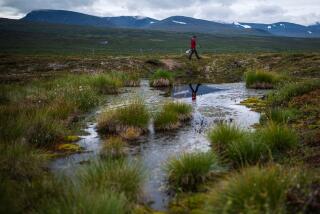Global Warming Threat Is Seen in Siberian Thaw
- Share via
Ancient woolly mammoth bones and grasslands locked in the Siberian permafrost are starting to thaw and could potentially unleash billions of tons of carbon dioxide into the atmosphere, accelerating global warming, a team of Russian and American scientists has concluded.
The area involved is vast -- 400,000 square miles. If the permafrost continues to thaw and releases heat-trapping carbon dioxide, it could dramatically increase the 730 billion metric tons already in the atmosphere, the scientists said in a study published in today’s issue of the journal Science.
“It’s like taking food out of your freezer ... leave it on your counter for a few days, and it rots,” University of Florida botany professor Ted Schuur said in a phone interview from Alaska, describing the process by which decaying animal and plant matter in the soil is converted by bacteria into carbon dioxide, methane and other greenhouse gases.
The research team concluded that previous studies on global warming had not taken into account the deep carbon reserve trapped in permafrost in the northern plains of Siberia and central Alaska.
The scientists said what was most surprising was the size and depth of the terrain that could be affected -- a piece two-thirds the size of Alaska and an average of 80 feet deep containing about 500 billion metric tons of carbon.
“It’s like finding a new continent under the Earth,” lead author Sergey Zimov said in a telephone interview from northern Siberia. He said the vast, carbon-rich area had been buried over many millennia by a unique layer of wind-borne loess dust that covered bones of mammoth, bison, saber-toothed tigers and the abundant grasses they fed on, then froze about 10,000 years ago into permafrost.
Contrary to earlier assumptions that permafrost was as barren as the polar desert, samples taken by the research team found 10 to 30 times as much carbon as in deep soils elsewhere. Schuur said most previous studies looked at samples about 3 feet deep.
Scientists, including this team, are working to document how fast the permafrost is melting. A 2005 study by the U.S. Center for Atmospheric Research estimated that about 10 feet of permafrost would melt in the 21st century, meaning billions of tons of gases could be released if global warming was not slowed or halted.
The Russian-American research team, funded by the National Science Foundation in the U.S., found that carbon stored over tens of thousands of years could bubble up from thawed soil in as little as 100 years.
“Because this is a very sensitive sort of climate, if the permafrost begins to melt, billions of gallons of greenhouse gases will be released from these ancient soils,” Zimov said.
The authors said they hoped the findings would spur quicker reductions of greenhouse gas emissions from cars and other sources.
“It’s not hopeless,” Schuur said. “We’re just at the beginning of this cycle, so we can, through the controlling of emissions, have a hope of slowing down this rate of global warming that would slow the melt of the permafrost.”






